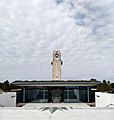Villers–Bretonneux Australian National Memorial facts for kids
Quick facts for kids Australian National Memorial, Villers-Bretonneux |
|
|---|---|
| Commonwealth War Graves Commission | |

View of the memorial tower (left) and Cross of Sacrifice (right)
|
|
| For Australian Imperial Force | |
| Unveiled | 22 July 1938 |
| Location | 49°53′12.76″N 02°30′45.97″E / 49.8868778°N 2.5127694°E ACoordinates: Extra unexpected parameters France |
| Designed by | Sir Edwin Lutyens |
|
To the Glory of God and in memory of the Australian Imperial Force in France and Flanders 1916–1918 and of eleven thousand who fell in France and have no known grave
|
|
| Statistics source: Cemetery details. Commonwealth War Graves Commission. | |
The Australian National Memorial, Villers-Bretonneux is a special place in France. It remembers all the Australian soldiers who died in World War I on the Western Front. This was a major battle area in France and Belgium.
The memorial is located near the towns of Fouilloy and Villers-Bretonneux in the Somme area of France. It lists the names of 10,773 Australian soldiers. These soldiers were part of the Australian Imperial Force. They died between 1916 and the end of the war. Their bodies were never found or identified.
The memorial stands where Australian soldiers fought bravely. They played a key role in the Second Battle of Villers-Bretonneux in April 1918. This battle was very important.
Sir Edwin Lutyens designed the memorial. It has a tall tower inside the Villers-Bretonneux Military Cemetery. The cemetery also has a Cross of Sacrifice. Walls and panels around the tower list the names of the missing soldiers. The main message is written in both French and English. The Commonwealth War Graves Commission takes care of the memorial and cemetery.
Contents
Building the Memorial
Choosing the Location
After World War I, Lieutenant General Sir Talbot Hobbs picked out places for Australian memorials. He suggested building a main memorial in France. This memorial would honor all Australians who died on the Western Front. The area around Villers-Bretonneux was chosen.
The Australian government agreed to this idea in 1923. A competition was held in 1925 to design the memorial. Only Australian veterans or their parents could enter. They had to use stone from Australia for their designs. William Lucas, an architect from Melbourne, won the competition. The French government approved the plan in 1929.
Changes to the Plan
In 1930, the project was paused. This was because of the Great Depression, which made money scarce. Also, the design by William Lucas was thought to be too expensive. Some people also didn't like how it looked.
Later, in 1935, Sir Fabian Ware visited Australia. He was in charge of the Imperial War Graves Commission. He suggested a new, cheaper design. This time, French stone would be used. Sir Edwin Lutyens was asked to create this new design.
Construction and Opening
The memorial was built in 1936 and 1937. King George VI officially opened it on July 22, 1938. His speech was even broadcast live to Australia!
Other important people were there, like French President Albert Lebrun. Australia's deputy prime minister, Earle Page, was also present. King George VI's wife, Queen Elizabeth, was with him. Her brother had died in the Battle of Loos during the war.
This memorial was the last big memorial built for World War I. Just over a year after it opened, World War II began. King George VI ended his speech with these words: "They rest in peace, while over them all Australia's tower keeps watch and ward."
Remembering the Fallen
Every year on April 25, a special Anzac Day Dawn Service is held at the memorial. This service starts early in the morning, at 5:30 AM. It is organized by the Australian Government. After this, other community services take place in Villers-Bretonneux and Bullecourt.
The cemetery originally had 60 hornbeam trees planted in 1928. These trees were removed in 2009 because they were old. New trees were planted for the 100-year anniversary in 2018.
The Sir John Monash Centre opened in April 2018. It is an interactive museum behind the memorial. It helps visitors understand the Australian experience on the Western Front.
Notable People Remembered
- Private Thomas Cooke – An Australian Army soldier born in New Zealand. He received the Victoria Cross (VC), which is a very brave award.
Images for kids











